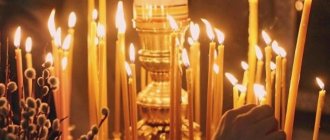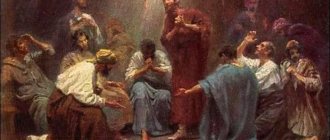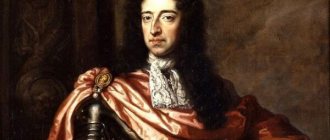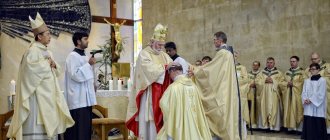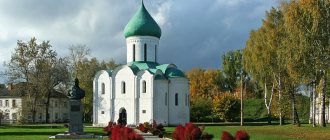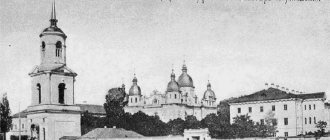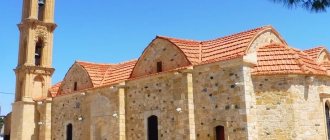What are the candlesticks in church called?
Candlesticks
In an Orthodox church, light symbolically denotes the image of Divine, heavenly light.
It also marks Christ as the Light who appeared to the world, the Light that enlightens every person. In ancient Byzantine-Russian churches there were always very narrow windows, which created twilight in the temple. And this meant earthly life, which is immersed in the darkness of ignorance and sin. Dusk was, as it were, an image of spiritual darkness, a kind of cover with which God’s secrets seemed to be surrounded for man.
Since ancient times, candles and lamps have been of great importance during worship. They burn in the altar in a special lamp (seven-branched candlestick), and near some icons in the altar part. Lamps are also lit near the icons in the middle part of the temple. Near especially revered icons, several lamps are lit at once. In addition, large candlesticks are also placed there, with cells for many candles. The candlestick in the temple serves precisely so that any believer can light a candle to the icons. In this case, a large candlestick is always placed in the central part of the temple. A candlestick with a large candle is used in the church at the great and small entrances during services. A large candle at the same time signifies the light of Christ’s preaching and Christ himself, personifying the Light from the true Light. Exactly the same meaning is attached to the candle in the candlestick, which is used together with the censer during the Liturgy of the Presanctified Gifts.
The central part of the temple contains a large lamp descending from the dome downwards. It has many fires that are lit on special occasions. This lamp is called a chandelier. Similar lamps also descend into the temple from the domes of the side aisles. These lamps are smaller in size and are called polycandiles. They have from seven to twelve lamps, while chandeliers have more than twelve.
There are several lamps hanging in front of almost every icon case; in addition to them, there are candlesticks with lit candles.
Candlesticks are made of bronze and brass. Each of them is designed for a certain number of candles. Parishioners light candles, for example, for health or repose, and placing a candle together with a prayer means zeal in faith.
The first candlesticks in temples
If we return to the reality of Orthodox traditions, we can see that the first candlesticks were simple to manufacture and simple in their geometric shapes. A dish was mounted on a regular stylized rod, at the bottom of which lighted candles were placed. However, today the craftsmen who make Orthodox decoration are free in their creative fantasies. Almost all individual details are subject to skillful decoration based on biblical scenes. Typically the base is made up of twisted columns. In many cases, craftsmen give the rod of a floor candlestick the shape of a tree trunk entwined with grape branches. The dish is also decorated in every possible way. A sublimated biblical story is created, which is complemented by the Divine monumentality of the product.
Our enterprise for the production of utensils offers Orthodox Temples to buy church candlesticks at the best prices. A single-candle lamp, which believers call a “skinny candle,” is inexpensive. It is shaped like a cylinder, which is richly decorated with fragments of biblical reality. True, recently they are rarely found in Orthodox religious institutions, but this is their value. Today our company offers a church floor candlestick to buy or order according to drawings developed by ministers of the Orthodox Church. A skillfully made candlestick immediately catches the eye of parishioners, associating in the minds of believers with the “burning bush”, with the Holy Fire, which for a long time showed the way to the Israelites during their life in the desert.
Production and sale of brass candlesticks
We not only produce custom candlesticks, our company’s assortment includes various models of this church utensil of compact and large sizes. Customers can purchase simple candlesticks or richly decorated ornate ones, ranging in height from 50 to 520 mm, designed to hold a variety of candles. Many of them are the development of our craftsmen, who in the manufacturing process were guided by the best examples of church utensils from the most famous Orthodox churches. We offer candlesticks made of brass and bronze, materials that are most suitable for this type of church utensil. Some models have decorative elements made of colored glass
What is a church candlestick?
In a Russian Orthodox church you can see many candlesticks, designed for parishioners to light candles in front of the icons. The most common design these days is a rectangular or round table
on a high
leg
with many holes for candles.
Sometimes a candlestick for many candles is called polycandyl
, although more often this word refers to a small temple chandelier with several light sources.
Varieties
Central
candlestick is usually the largest. A lamp is usually installed in the center of such a candlestick.
Regular
candlesticks - placed in front of icons, relics, crucifixes. They can be round or multifaceted, less often rectangular, with or without a lamp.
Children's
floor candlesticks differ from adult candlesticks in their smaller height. Thanks to this, it is convenient for children to place candles on them.
Eve
(canon, tetrapod) – funeral candlestick, funeral table.
Hanging
candlesticks (kandila). They are much less common than floor-mounted ones. In Orthodox churches, they are usually placed in front of revered icons. Such a candlestick may have holes for one or more candles, as well as a glass for a lamp.
Helpful advice
Before you start placing candles on a metal candlestick, generously lubricate it with lamp oil. This will make it easier to clean the candlestick from frozen drops of wax and protect it from damage.
According to fire safety requirements, the candlestick must be placed on a non-flammable surface. In addition, you should take care that the wax does not fall on the temple floor, otherwise stains will remain on it. circles specially cut from suitable materials (for example, linoleum).
.
From the history
In the old days in Russia there was such a version of a floor candlestick for a temple as a skinny
(or stand-on)
candle
. This is a candlestick, the leg of which is made in the form of a cylindrical column and itself resembles a huge candle. As a rule, such candlesticks were decorated with rich paintings or carvings. Initially, they were made from a wooden block that was hollow inside, and later from porcelain. The ornament that adorned the “skinny candle” symbolized the tabernacles of paradise and was an interweaving of strange plants.
What is a liturgical candlestick?
Remote candlesticks for clergy are a handle into which one or more candles are inserted.
Typically, church candlesticks are made of brass, sometimes of aluminum. History knows gold and silver candlesticks for clergy. They are often elegantly decorated: with enamel, gilding, and stone inserts.
There are deacon and priest candlesticks with a wooden handle, less often - completely wooden.
Varieties of liturgical candlesticks
A portable candlestick
is taken out of the altar and placed in front of the Royal Doors at certain moments of the service. It is a tall thin cylinder on a stable stand, in the upper part of which there is a hole for one thick candle. Its height is usually about one and a half meters.
The remaining liturgical candlesticks are handmade. Candlesticks of a certain type are used by bearers of various ministries: bishops, priests, deacons.
The deacon's candlestick
is designed to hold a thick candle - usually four centimeters in diameter.
It has a long handle, thanks to which the candle is raised significantly higher than the hands of the person holding it. In the old days in Rus', the deacon’s candle was called oslopnaya, from the word “oslop” - club, stick. Indeed, the deacon's candlestick
is much more massive than the one carried in the priest's hand. Usually its length exceeds 40 centimeters, and sometimes approaches a meter. This type of candlestick is a long, smooth handle, usually hollow inside. Thanks to the length of the deacon's candlestick, the candle inserted into it looks solemn, even if most of it has already burned out. This candlestick can be held with one or two hands. Similar candlesticks are held in the hands of altar servers (sextons) at certain moments of the service.
Church candlestick: what is it like?
In modern churches, the church candlestick has lost many of its functions; some varieties of this utensil are not used due to replacement with electric lamps. Of course, they try to select chandeliers in churches and other lighting fixtures that are as similar in shape as possible to traditional candlesticks.
But, of course, not all types of candlesticks have ceased to be used in churches. For example, the church candlestick for the needs of worshipers has not disappeared anywhere. These utensils are still used during services. Also, church shops always offer a wide range of both candlesticks and lamps for home use by believers.
What types of candlesticks are there?
There are quite a few varieties of this utensil, but not every temple uses all existing types of candlesticks, as well as electric lamps.
Multi-candle utensils can be presented either in the form of a simple dish, or decorated with separate holders. If decorated, they can hold 12, 24, 48 or even more candles. Often such a church candlestick is tiered and complemented by an insert for incense.
From the history of candlesticks for worship
The symbolism of the candlestick
developed in the Church in such distant times that it remained practically common among the Orthodox, Old Believers and even Catholics. You can verify this by looking at the photographs, which show almost identical items of church utensils.
candles during worship spread
(and this happened already in early Christian times), candlesticks also appeared.
The purpose of a candlestick held in the hands of a clergyman or clergyman is not only the convenience of the holder, but also the desire to raise the candle high enough, in accordance with the words of the Savior: “ They do not put a lamp under a bushel, but on the candlestick, and it gives light to everyone in the house
.”
About the seven-branched candlestick
This type of candlestick is rarely found in modern churches. In city churches it was replaced by electric lamps, similar in appearance to a candlestick.
This is a church floor candlestick. It is designed for seven candles or has inserts for the same number of lamps. This type of utensil is traditionally installed on the eastern side of the throne in the amount of one piece. However, during large services the number of seven-branched candlesticks can be increased and their location changed.
About altar candlesticks and lamps
Altarpiece - a candlestick installed by the priest. Under a church candle, one used during services. Altar candlesticks are always paired. Each of them contains one large and beautiful candle. These utensils are installed on the eastern ends of the throne - from the north and from the south.
Lamps come in two main types, according to their purpose and method of use. The first type is a church candlestick, semi-closed and, as a rule, hung on the wall. There are also lamps that are not intended for candles, but are simply filled with oil. They were the first Christian lamps. Such lamps are not used in divine services; their function is only one - to illuminate the temple premises.
The second type of lamps is used during church services. This is a portable candlestick carried by a deacon and called a “kandil”. Often such utensils are called polyeleos candlesticks.
About dikiriy, trikirium and candlestick for one floor candle
Dikiriy, like trikiriy, is a festive, ceremonial utensil. Bishops use it when performing solemn services. Two candles are installed in the dikiri, and three, respectively, in the other candlestick. During the course of the service, the bishops bless the believers with their help. The candles used in these types of utensils have their own names - autumn, two- or three-wicker.
It is rare now to see a large and heavy candlestick standing on the floor in an active temple. Due to electrification, there was no place left in the halls for a church candle, large and burning for a long time. Although some churches have preserved this utensil and use it to decorate the room before special services, it is easier to see such a candlestick in museums than in churches. This type of candlestick is called “voshchanitsa”. Externally, it is a cylindrical candle stand placed on a high “leg”, fancifully and extremely richly decorated.
The spiritual and symbolic meaning of candlesticks for liturgical candles
In the candlestick we can see a metaphor for reverence: we touch the source of light (which symbolizes grace) not directly, but by holding it with the help of beautifully decorated utensils. However, there has never been a prohibition against holding a candle during a service without a candlestick.
Trikirium
– a candlestick with three candles, symbolizes the Holy Trinity.
Dikiriy
- carries two candles and reminds believers of the two natures of the Lord Jesus Christ: Divine and human.
Primicirium
- speaks of the unity of the Church, that its Primate is the image of Christ.
A burning candle in the hands of a priest and deacon symbolizes the light of the Gospel sermon.
Source
About candlesticks for the needs of believers
These are the utensils on which worshipers place candles in front of the images of saints. Their execution may be different; there are no canonical restrictions on the form or appearance of such utensils.
As a rule, in small churches with a small number of parishioners, small candlesticks that are simple in shape are used. Usually in modern churches, utensils are placed with separate holder molds for each candle and a place for a lamp or incense burner in the upper center part.
If a temple receives a different number of believers, for example, located near roads or near large markets, then in its hall a candle stand is usually used without separate molds, in the form of a simple large dish. Regardless of the presence or absence of holders for each candle, such church items can be either single-tiered or reminiscent of a bookcase. Tiered candlesticks are usually installed in large churches, such as cathedrals.
Source
The most important part of the temple is the altar . In the altar, Divine services are performed by the clergy and the most sacred place in the entire temple is located - the holy altar , on which the sacrament of Holy Communion is performed. The altar is placed on a raised platform. It is higher than other parts of the temple, so that everyone can hear the service and see what is happening in the altar.
The throne is a specially consecrated quadrangular table, located in the middle of the altar and decorated with two clothes: the lower one is white, made of linen, and the upper one is made of more expensive material, mostly brocade. On the throne, mysteriously, invisibly, the Lord Himself is present, as the King and Ruler of the Church. Only clergy can touch and kiss the throne.
On the throne there is an antimension, a Gospel, a cross, a tabernacle and a monstrance.
An antimension is a silk scarf (scarf) consecrated by a bishop, with a depiction on it of the position of Jesus Christ in the tomb and, necessarily, with a particle of the relics of some saint sewn on the other side, since in the first centuries of Christianity the Liturgy was always performed at the tombs of martyrs. Without an antimension, the Divine Liturgy cannot be celebrated (the word “antimension” is Greek, meaning “in place of the throne”).
For safety, the antimension is wrapped in another silk board called iliton . It reminds us of the sir (plate) with which the Savior’s head was wrapped in the tomb.
On the antimension itself there is a lip (sponge) for collecting particles of the Holy Gifts.
The Gospel is the word of God, taking into account our Lord Jesus Christ.
The cross is the sword of God, with which the Lord defeated the devil and death.
The tabernacle is the name given to the ark (box) in which the Holy Gifts are stored in case of communion for the sick. Usually the tabernacle is made in the form of a small church.
The monstrance is a small reliquary (box) in which the priest carries the Holy Gifts for communion with the sick at home.
Behind the throne there is a seven-branched candlestick , that is, a candlestick with seven lamps, and behind it an altar cross . The place behind the throne at the very eastern wall of the altar is called the mountain (high) place ; it is usually made sublime.
To the left of the throne, in the northern part of the altar, there is another small table, also decorated on all sides with clothes. This table is called an altar . Gifts for the sacrament of communion are prepared on it.
On the altar are the sacred vessels with all their accessories, namely:
1. Holy Chalice , or chalice , into which before the Liturgy wine and water are poured, which are then offered, after the Liturgy, into the blood of Christ.
2. Paten - a small round dish on a stand. Bread is placed on it for consecration at the Divine Liturgy, for its transformation into the body of Christ. The paten marks both the manger and the tomb of the Savior.
3. Star , consisting of two small metal arcs connected in the middle with a screw so that they can either be folded together or moved apart crosswise. It is placed on the paten so that the cover does not touch the particles taken out of the prosphora. The star symbolizes the star that appeared at the birth of the Savior.
4. Spear knife, similar to a spear, for removing the lamb and particles from the prosphora. It symbolizes the spear with which the soldier pierced the ribs of Christ the Savior on the Cross.
5. Liar - a spoon used to give communion to believers.
6. Sponge or cloth - for wiping blood vessels.
Small covers that cover the bowl and paten separately are called covers . The large cover that covers both the cup and the paten together is called air , signifying the air space in which the star appeared, leading the Magi to the manger of the Savior. Nevertheless, together the covers represent the shrouds with which Jesus Christ was wrapped at birth, as well as His burial shrouds (shroud).
All these sacred objects must not be touched by anyone except bishops, priests and deacons.
On the altar there is also a ladle in which, at the beginning of the proskomedia, wine and water are served to be poured into the holy cup; then, before communion, warmth (hot water) is supplied in it, and the drink after communion is taken out in it.
In the altar there is also a censer or censer - a vessel mounted on a chain that distributes fragrant smoke - incense (incense). Ceremony was established in the Old Testament church by God Himself. Ceremony before St. the throne and icons expresses our respect and reverence for them. Every prayer addressed to those praying expresses the wish that their prayer would be fervent and reverent and would easily ascend to the sky, like incense smoke, and that the grace of God would overshadow the believers as the smoke of incense surrounds them. Believers must respond to incense with a bow.
The altar also contains dikiriy and trikyriy , used by the bishop to bless the people, and ripids .
A dikirie is a candlestick with two candles, symbolizing the two natures in Jesus Christ - Divine and human.
A trikirium is a candlestick with three candles, symbolizing our faith in the Holy Trinity.
Ripids or fans are metal circles attached to the handles, with images of cherubs on them. Deacons blow ripids over the gifts during their consecration. Previously, they were made from peacock feathers and were used to protect St. Gifts from insects. Now the spirit of ripid has a symbolic meaning; it depicts the presence of heavenly forces during the sacrament of Communion.
On the right side of the altar there is a sacristy . This is the name of the room where vestments are stored, that is, sacred garments used during Divine services, as well as church vessels and books with which Divine services are performed.
In front of the icons and lecterns there are candlesticks on which believers place candles. Parishioners take candles from a candle box - a special place at the entrance to the temple. A lit candle means our fiery love for God, the Most Holy Theotokos and all the saints to whom we turn with prayers.
In a special place of the temple (usually on the left side) a kanun - a small table with an image of the Crucifixion and cells for candles, which believers place for the repose of loved ones, relatives and friends.
In the middle of the temple, at the top of the ceiling, hangs a chandelier , that is, a large candlestick with many candles. The chandelier is lit during solemn moments of the service.
The following works were used in preparing the material: “The Law of God,” Archpriest Seraphim Slobodskaya. “Orthodoxy for children”, O.S. Barilo.
